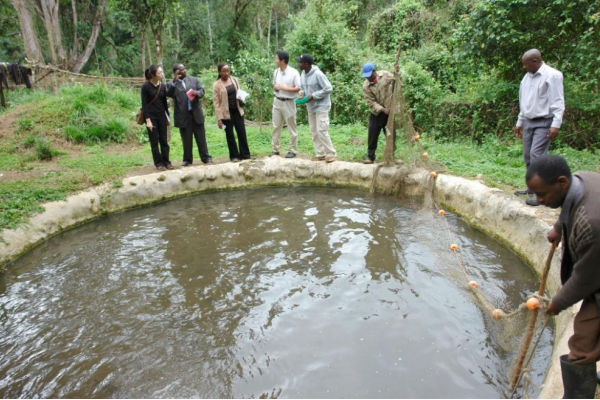Fish for the future – Cold fish farming on the slopes of Mt. Kenya

Summary
This project, implemented on the slopes of Mount Kenya, emerged from local community members with the aim of addressing the lack of viable livelihoods for youth resulting from a combination of environmental and other factors. It was initiated in 2004 by the self-help group Jitunze Environmental Group (JEG), originally consisting of about 20 youth.
Mount Kenya is the highest mountain in Kenya and the second-highest on the African continent. Although the mountain is just under 100 kilometers north of the equator, glaciers are still found, due to the mountain’s high altitude. However, the mountain is already suffering from the effects of a warming climate and has seen an immense reduction in its glaciers. The reduction in water flow severely affects most of the mountain communities and those in the immediate lowlands, as they rely primarily on subsistence agriculture supported by natural water flow. These problems threaten the livelihoods of mountain people and create conflicts over resources between lowlanders and uplanders. Reduced agricultural production greatly affects vulnerable communities due to reduced living standards. Youth are among the most vulnerable categories and many no longer find agriculture a viable livelihood.
Through this initiative, which consists of the breading and farming of cold trout fish, JEG contributes to food security, environmental conservation, and sustainable development in the targeted areas. It represents an adaptive solution to the evident climate changes that impact the region, such as low river water flow and deforestation. In addition, it has also contributed to revitalizing the forests by supporting the planting of some 100,000 trees in the Mount Kenya region, which in turn helps to keep the ponds at the required cool temperatures by reducing local temperatures, providing shade, and protecting their much-needed water supply from drying out.
Overview
- Location:
- Implementation sites:
- Single country
- Single location
- Mountain region:
- Mount Kenya
- Solution scale:
- Solution type(s):
- Sector(s):
- Climate impact(s) addressed:
- Impact time-scales:
- Co-benefits:
- Implementation timeline:
- 2004 - 2022
Solution details
Main beneficiaries & outcomes
The project directly benefits young people in the area. These are part of the 26-member self-help group, of which 11 are men and 15 are women.
Both direct and indirect employment opportunities are generated through a multiplier effect in engaging Business Delivery Service Providers through the value chain. As of 2016, around 101 beneficiaries benefited from this alternative livelihood, being able to earn an income, which in turn has reduced the need for cutting down trees to sell charcoal in the region. Likewise, the number of community members trained annually has increased from 2,000 to 3,000.
Because trout is a nutritious food product, the business, therefore, contributes to local and regional food security. Besides, the initiative has also tried to support the local ecosystem by planting trees.
Planning and implementation
The solution is being implemented by the Jitunze Environmental Group (JEG), formed in 2004 to create its own fish farms as an adaptive solution to difficult economic circumstances. Group members learned about this business through a colleague who had participated in leadership training in the United States of America, and a few years later, after efforts to raise sufficient funds and obtain the relevant permits from the Department of Fisheries, they built their first pond in 2008. In those four years, they had raised 505,440 Kenyan shillings (approximately $4,500) which they spent on building three ponds, cementing them, constructing a small hatchery, installing water pipes, and purchasing their initial stock of 500 fish from a state-owned trout farm. In 2015, the number of ponds increased to 18 due to higher revenues from the high demand for trout, indicating the success of their venture.
The implementation of this project is based on the formation of self-help groups of young people, who subsequently raise financial resources and labor to start the trout fish farming. Knowledge and skills for these beneficiary groups are provided by the JEG.
Finance
The members of the self-help group mobilized the initial financial resources and labor on their own and are currently supported by the project’s profits. As described above, newly formed groups are also responsible for raising their own initial resources.
Innovation
The implementation of this solution is an innovative approach to address the climatic and economic challenges faced by the people of this mountainous area. The creativity applied by the young people in the project makes it possible to use the cold water available in the Kenyan mountains to raise trout fish, which require specific living conditions (i.e. well-functioning hydro-logical system). In this way, the solution provides an alternative source of livelihood and promotes environmental protection.
Long term project sustainability and maintenance
The maintenance activities of the breeding facilities and ponds are carried out by the participating groups themselves thanks to the training provided by the JEG. Although no environmental monitoring assessment is known to have been carried out, the participants pay special attention to the care of some environmental aspects of the area, such as the constant flow of clean water from the rivers, which is necessary for the successful breeding of this type of fish that require very specific living conditions. All of the water used can be returned to the rivers for reuse because it is free of pollutants.
Outlook & Scalability
Transformation and future outlook
This solution promotes an important change in the area of the slopes of Mount Kenya by promoting innovative adaptation to current environmental conditions while helping the population to abandon other unsustainable practices such as deforestation for the production and sale of charcoal. Furthermore, the project has served to raise awareness in the area about the care of natural resources.
Potential for upscaling and replication
The replicability potential of this solution is considered high not only for the region where the project is currently working but also for other parts of Kenya. Scaling up of the enterprise has already taken place since the establishment of the first fish farm; however, due to the increasing demand for fish, the project is planned to be further scaled up by expanding the existing JEG trout farm, and by stimulating further investment in trout farming by other groups in the community.







(0) Comments
There is no content